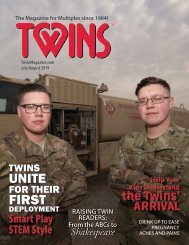Twins Magazine 2004 January February
Canadian family with four sets of twins sets Hardwired to Connect HMO forced to pay for TTTS surgery Holiday Survival Guide Oh my word! RSV season symptoms and strategies Sparkling Snowflakes The best-laid plans The hamster project Those “loving feelings” are hard to find Twins galore Two treatments help TTT babies Uh-oh! Toddler Trials and Training What causes monozygotic twinning Whining wears on single mom Help! I need somebody…
Canadian family with four sets of twins sets
Hardwired to Connect
HMO forced to pay for TTTS surgery
Holiday Survival Guide
Oh my word!
RSV season symptoms and strategies
Sparkling Snowflakes
The best-laid plans
The hamster project
Those “loving feelings” are hard to find
Twins galore
Two treatments help TTT babies
Uh-oh! Toddler Trials and Training
What causes monozygotic twinning
Whining wears on single mom
Help! I need somebody…
You also want an ePaper? Increase the reach of your titles
YUMPU automatically turns print PDFs into web optimized ePapers that Google loves.
Special Miracles
by Karen Johnston
HMO forced to pay for TTTS surgery
When I was 12 weeks pregnant, I learned
I was having twins. At 14 weeks, specialists
found that the twins I was carrying
had Twin-to-Twin Transfusion Syndrome
(TTTS). I opted for laser surgery to save
my twins because my only alternative was
termination. My insurance company
denied this coverage.
My doctor, Dr. Acker, recommended
that I research the condition to educate my
husband and myself for the decisions to
come. He also suggested that I contact Dr.
Ruben Quintero at the Florida Institute for
Fetal Diagnosis and Therapy to obtain
more information on laser photocoagulation
surgery.
An ultrasound at 16 weeks showed that
the twins’ situation was considerably
worse. The recipient baby had significantly
more amniotic fluid than she had
had two weeks earlier, and the donor baby
was now stuck to my cervix and had very
little amniotic fluid in her sac. Her kidneys
were visible on ultrasound, but her
bladder was not. Based on the presence
of polyhydramnios/oligohydramnios in
the twins, and the absence of the donor
twin’s bladder on ultrasound, I was diagnosed
with Stage II TTTS. This condition
is extremely serious, particularly when it
appears prior to 25 weeks.
The early presentation of the condition
and its severity left us two choices.
We could choose to terminate the pregnancy
immediately, or let nature take its
course over the next few weeks and the
pregnancy would terminate itself. Or we
could opt for laser photocoagulation surgery
to treat the underlying pathology
itself. Dr. Acker felt that serial amniocentesis,
a common treatment, was not an
option for us.
Pregnancies that develop signs of
TTTS after 26 weeks’ gestation usually are
managed by serial amniocentesis, also
known as amnioreduction, as the fetuses
are at a viable age and theoretically able
to live outside the womb. It is a means of
preventing pre-term labor and the success
rate may be as high as 50% to 60%.
Jessica Marie and Alyssa Renee, at 6 weeks
For a number of reasons, success rates
for this procedure prior to 26 weeks are
not nearly as high. To begin with, removing
extra amniotic fluid from the recipient
twin’s sac does nothing to address the
underlying issues.Amnioreduction before
26 weeks carries risks of infection and
bleeding, and repeat treatments significantly
increase the risk of membrane rupture,
which can effectively produce
monoamniotic twins. Finally, amnioreduction
is associated with a high risk of
cerebral palsy.
With the early onset and clinical severity
of my twins’ TTTS, amnioreduction
would pose an unacceptably high risk of
pregnancy loss, spinal or brain deformities
and extremely premature birth. My
doctor suggested laser photocoagulation
by Dr. Quintero as our only viable treatment
option if we intended to continue
to the pregnancy. Dr. Quintero has performed
close to 300 surgeries of this
nature and is considered the world’s leading
authority on this procedure. As my
HMO repeatedly pointed out, this surgery
is still considered experimental, and as
such, must be performed by the most
experienced surgeon in this field in order
to obtain the best chance at success.
Tufts Health Plan denied coverage for
the surgery, suggesting that I enroll in an
on-going, NIH-funded clinical trial at the
Children’s Hospital of
Philadelphia. This trial is
a double-blind, randomized
trial, in which
participants receive
either serial amniocentesis
or laser photocoagulation
surgery, with the
treatment protocol.
I needed to have the
surgery as soon as possible,
and with the bestqualified
surgeon, or risk
losing my twins. Despite
the expert opinion of Dr.Acker—a boardcertified
maternal-fetal medicine specialist
who is also head of obstetrics and gynecology
at world-renowned Brigham and
Women’s Hospital and has focused his 25-
year practice on multiples pregnancies—
Tufts again denied coverage. My husband
and I even while awaiting the results of our
appeal with Tufts, flew to Tampa, Fla., for
the surgery at 17 weeks’ gestation. We
knew that the results of the appeal were not
going to affect our decision.
While in Florida I learned that Tufts
Health Plan had denied my appeal again.
We proceeded with the surgery nonetheless,
paying up front more than $18,000
for the procedure.
Jessica Marie and Alyssa Renee were
born on Nov. 13, 2002, at 28 1 ⁄2 weeks.
Shortly thereafter, the Office of Patient
Protection at the Massachusetts Dept. of
Public Health overturned Tufts Health
Plan’s denial of coverage and ordered the
HMO to pay in full.
We recently celebrated Jessica and
Alyssa’s first birthday—and our decision
to have this surgery.
Karen Johnston lives in Weymouth, Mass., with
her husband and thriving 14-month-old twin girls.
36 JANUARY/FEBRUARY 2004 www.TwinsMagazine.com

















